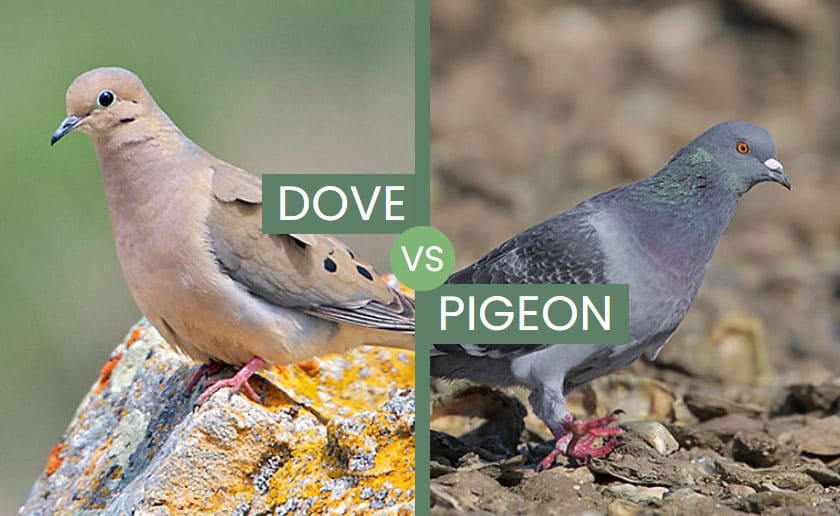Pigeons and doves are a distinct group of birds of great significance for the world – as a symbol, a food source, or, more broadly, an essential part of every ecosystem’s food web.
But what is the difference between birds we call “pigeons” and those we call “doves?”
The truth is that doves and pigeons constitute thesame bird family called Columbidae, or “Columbids.” The family features 300+ species – some commonly called “pigeons” and others “doves,” with many shared features.
These two groups do not represent subfamilies, nor is there any scientific cue about the dove-pigeon division. In fact, the two terms are sometimes used interchangeably for the same species!
Take the world-famous Columbidae member – the Rock Pigeon (Columba livia). This “pigeon” is also commonly called a “Rock Dove,” – and both options are correct.
Still, there must be some reason why we distinguish between pigeons and doves, right?
After exploring all the dove vs. pigeon characteristics – you be the judge.
Body & Shape
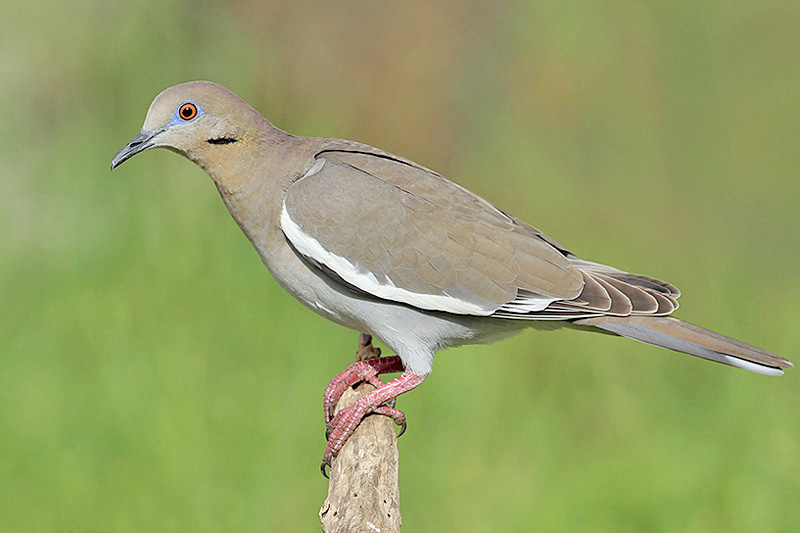
Doves tend to have a slimmer build.
Both doves and pigeons are similarly built – they have rounded bodies with short necks and smallish round heads featuring relatively short beaks.
However, the bigger, stockier Columbids often get the “pigeon” title, while the “doves” are usually smaller and slimmer.
Related: How common are albino pigeons?
In tune with that, doves tend to have longer, thinner tails that spread more in flight. The pigeon tails are usually shorter and stockier.
Again, don’t take this as a rule – rather a generalization.
Size
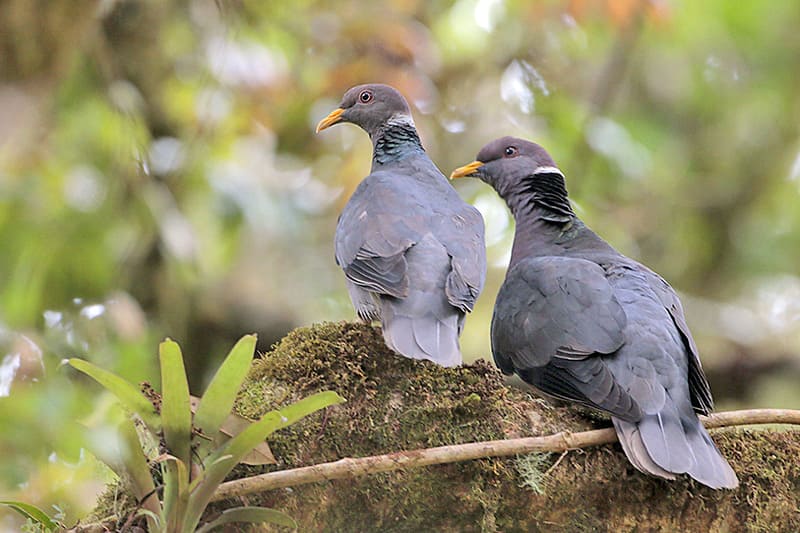
Pigeons are often a bit bigger in size.
As for body size (length, weight, and wingspan included), most pigeon species tend to be larger and bulkier than most doves.
Let’s compare some common pigeon and dove species that share the same range.
- The average size of the Common Woodpigeon (Columba palumbus), native to Eurasia, measures 16 inches in length and weighs 17-19oz; its wingspan is around 30 inches.
- The Eurasian Collared Dove (Streptopelia decaocto) is equally abundant and lives within a similar range as the woodpigeon; it’s about 13 inches long, weighs anywhere from 4.4-8.5 oz, and has a 20-inch wingspan.
- The European Turtle Dove (Streptopelia turtur) is even smaller than the Eurasian Collared Dove – 10 inches long, weighing only around 4 oz, and with a 20-inch wingspan.
The Largest and Smallest Specimen
The largest member of the entire family is the Victoria Crowned Pigeon (Goura victoria). This bird, originating from New Guinea and named after Queen Victoria, can measure 30 inches in length and weigh up to 7.7lbs! Besides the sheer size, it’s probably one of the most attractive pigeons in the world.
The biggest domesticated pigeon breed is the Giant Runt Pigeon – an ancient pigeon breed thought to originate from antique Rome. It can reach a length of 21 inches and a weight of up to 2 and a half pounds!
On the other (smaller) hand, the Common Ground Dove (Columbina passerina) is the smallest Columbid in North America and one of the family’s smallest members. Measuring 6-7 inches in length and weighing from 0.9-1.4oz, it is about the size of a Song Sparrow.
However, the Ground Dove is not the smallest one out there. The Dwarf Fruit Dove (Ptilinopus nainus) is found in rainforest foothills and lowlands of New Guinea – and it measures only 5-6 inches in length.
Speed
Both doves and pigeons are strong fliers and can propel themselves through the air at the speed of an average car!
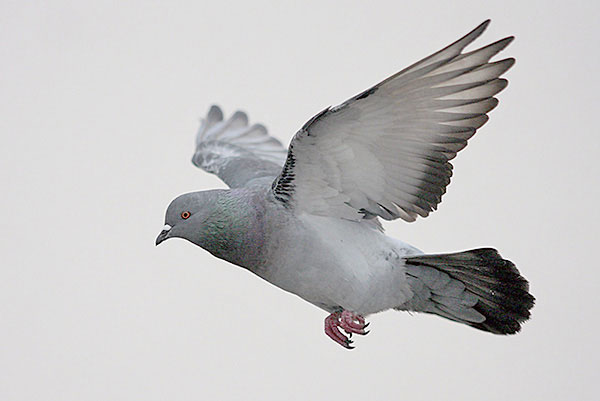
Photograph © Greg Lavaty
However, pigeons seem to be slightly faster in flight than doves. Let’s make some comparisons to check.
- The North American Mourning Dove (Zenaida macroura) can achieve a speed of up to 55 mph.
- The Turtle Dove is slower, reaching 37 mph, but can fly up to 430 miles without stopping during migration.
- Believe it or not, a common rock pigeon can sustain a speed of 60mph; however, the domesticated racing pigeon breeds can reach an impressive average speed of 90 mph!
Not all pigeons are athletic flyers, though. The aforementioned Victoria Crown Pigeon gets off the ground only to roost in trees and can’t fly great distances – let alone fly fast.
Age
The possible natural lifespan of both doves and pigeons is 10-20 years. However, this is different from the realistic average lifespan since the lives of many wild birds are cut short by predation, hunting, or injury.
It is estimated that a wild dove individual lives as little as two years on average and wild and feral pigeons 3-6 years. Still, even wild and feral doves and pigeons can reach older age.
We can better understand the possible pigeon lifespan by looking at captive birds.
Here are the record-holders:
- Methuselah, a white collared dove male, entered the Guinness Book of World Records in 2004 at the age of 29,5 years.
- Peace, a retired and rescued white racing pigeon, is the record-holder for the oldest pigeon in the world. In 2013 when he entered the Guinness Book, he was 24 years and 188 days old.
Behavior
The behavior of doves and pigeons largely depends on the species. This numerous bird family is found in various ecological niches, so lifestyles tend to differ significantly. They can be solitary or highly gregarious, timid or semi-tame, sedentary or migratory.
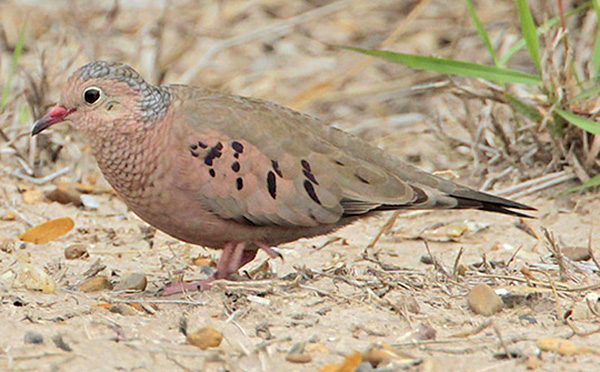
Photograph © Greg Lavaty.
However, all Columbids share some common behavioral traits.
- All pigeons and doves are diurnal – active during the day – and roost at night. Some migratory species fly at night during the migration.
- All pigeons and doves are monogamous and form pairs to raise young. A couple may stay together for life or at least many years.
- Most species become territorial and aggressive towards same-species and other intruders during the mating season; however, the aggression doesn’t include humans.
- All use piloerection – raising feathers or fluffing up – to regulate their body heat.
- All Columbids spend a lot of time sunbathing, dustbathing, soaking and bathing in water, and preening in general.
- All have a variety of songs, calls, and gestures and actively communicate with the members of the same species, indicating their social nature.
- Most have excellent navigation abilities.
Diet
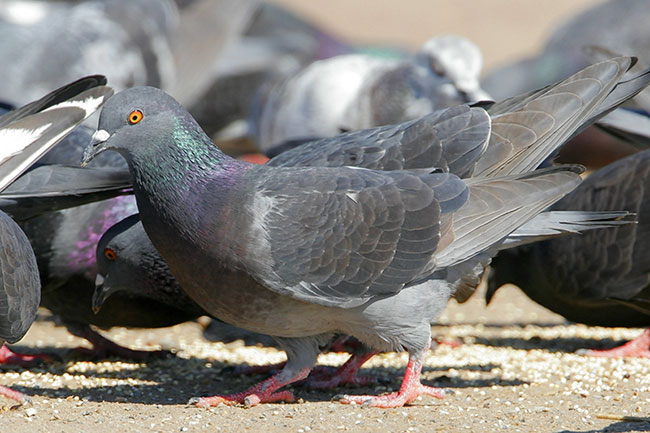
All Columbidae members are herbivorous – seed and fruit eaters. There is no distinction between doves and pigeons in respect of diet.
Related: What do pigeons eat?
However, the entire family is divided into subfamilies according to the species’ food preferences – depending on whether they primarily eat fruits or seeds.
- The subfamily Columbinae – true or typical pigeons and doves are granivorous (seed-eating).
- Other four subfamilies – Didunculinae (tooth-billed pigeons), Gourinae (crowned pigeons), Otidiphabinae (pheasant pigeons), and Treroninae (fruit doves, imperial pigeons, and relatives) are frugivorous.
Both “pigeons” and “doves” are found within these subfamilies.
Location
Pigeons and doves have a worldwide distribution. They are adapted to most of the Earth’s habitats – excluding Antarctica, the high Arctic, and the driest areas of the Sahara.
The Rock Pigeon (or Rock Dove, Columba livia) is the only bird that has truly conquered the world. Starting out from caves, canyons, and sea cliffs of Europe, North Africa, and southwest Asia, today, it is found on all continents except for Antarctica.
See more: Types of doves in the U.S.
However, other rock and pigeon species have a more local distribution, with Palearctic and Nearctic realms having similar but separate species. Unsurprisingly, the greatest diversity of species is found in the Tropics.
Nest & Eggs
Both pigeons and doves build simple, loose, rough nests in the shape of a platform or a shallow dish made from twigs.
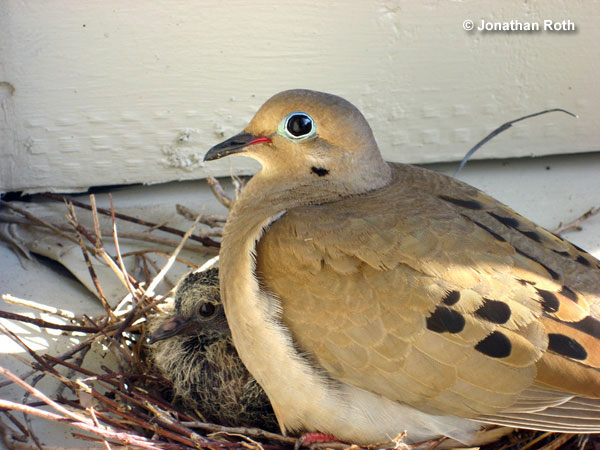
Mourning Dove in its nest
The most common spots for nest building are cliffs, trees, crevices, buildings (for feral rock pigeons and collared doves), and the ground (in the case of ground species). They also use abandoned nests from other similar-sized birds and reuse their own nests.
The nest-building lasts from two to four days; at this time, the pair will get territorial and actively defend the nesting site and the surrounding areas.
All Columbids lay one, two, or rarely three eggs; the fruit-eating species tend to lay only one egg, while grain-eaters can produce more. The eggs are white or buff-colored, with no spots or other markings.
Both males and females take turns incubating the clutch – although the females spend more time on the nest on average. Depending on the species, the incubation lasts from 11-30 days.
Frequently Asked Questions
Are doves and pigeons the same?
Scientifically speaking, doves and pigeons are the same group of birds – belonging to the bird family Columbidae. There is no separate zoological classification for pigeons and doves.
In fact, the term “dove” and “pigeon” is often used interchangeably, even for the same species, adding ever more confusion. For example, the most widespread columbid in the world is called “Rock Pigeon” and “Rock Dove” simultaneously.
However, linguistically and culturally, doves and pigeons are looked at differently.
What is the difference between a dove and a pigeon?
As said before, the true difference between doves and pigeons is exclusively the human perception and culture – the scientific difference is non-existent.
As for the differences, doves are considered elegant and noble birds, bringers of peace, and a symbol of purity. Historically, many were kept as cage birds.
On the other hand, pigeons have a more down-to-earth image – they are stocky birds with a value as ornamental and pet birds, a food source, a disease vector, and one of the trademarks of old European city squares. Also, pigeons were actively used in World War I and World War II as messengers and spy device carriers – hence the term “War pigeons.”
As for the language differences, the word “dove” stems from Norse, and “pigeon” is from French.

